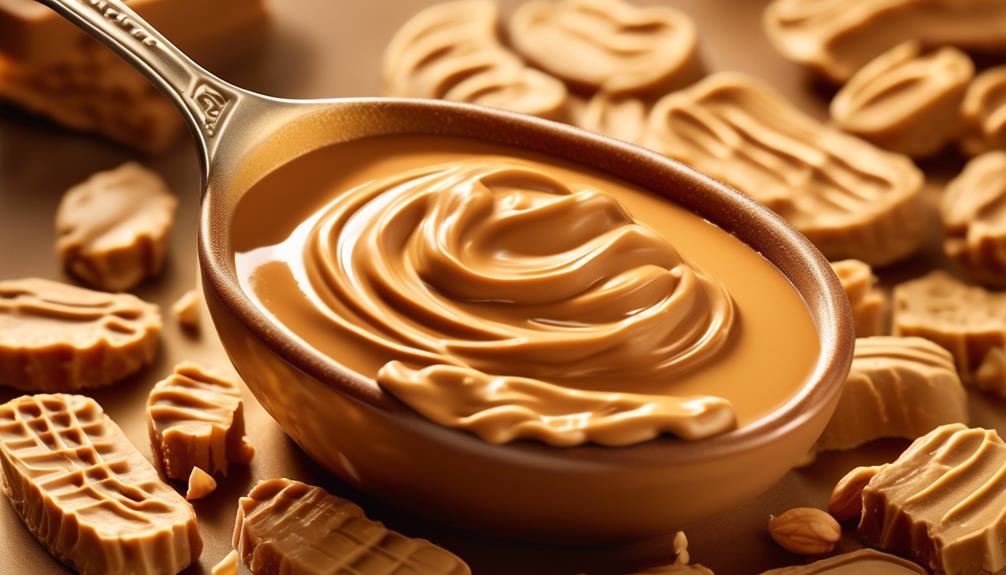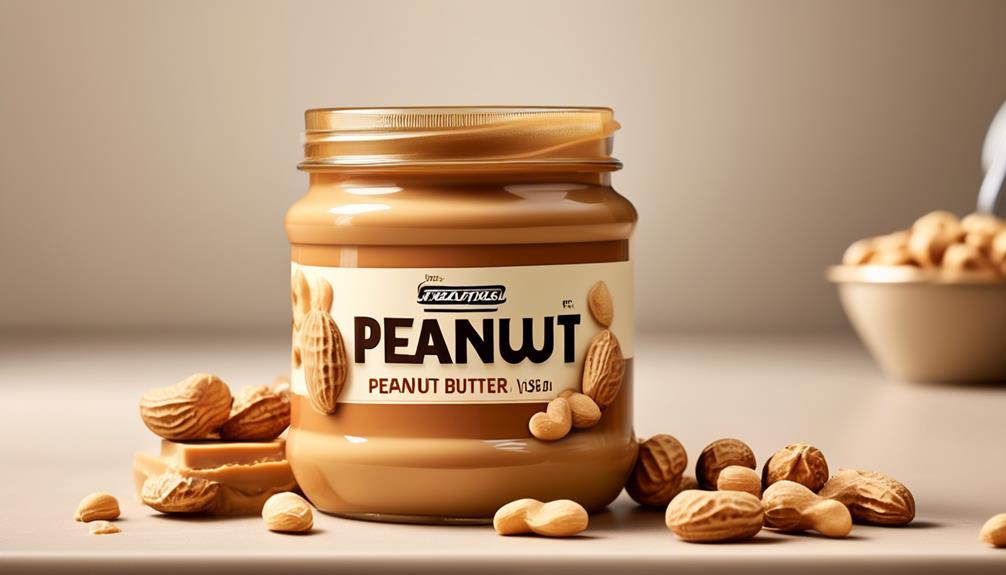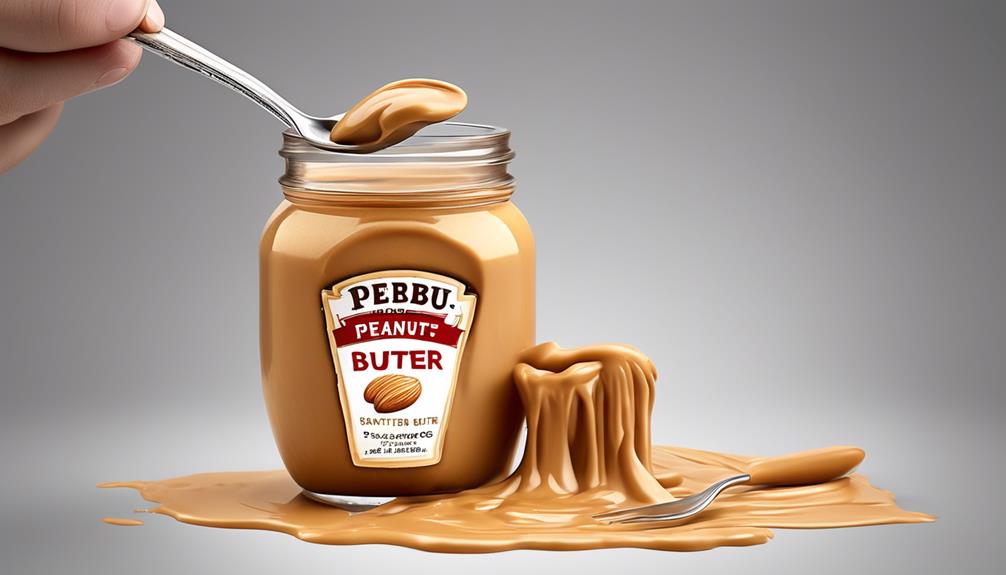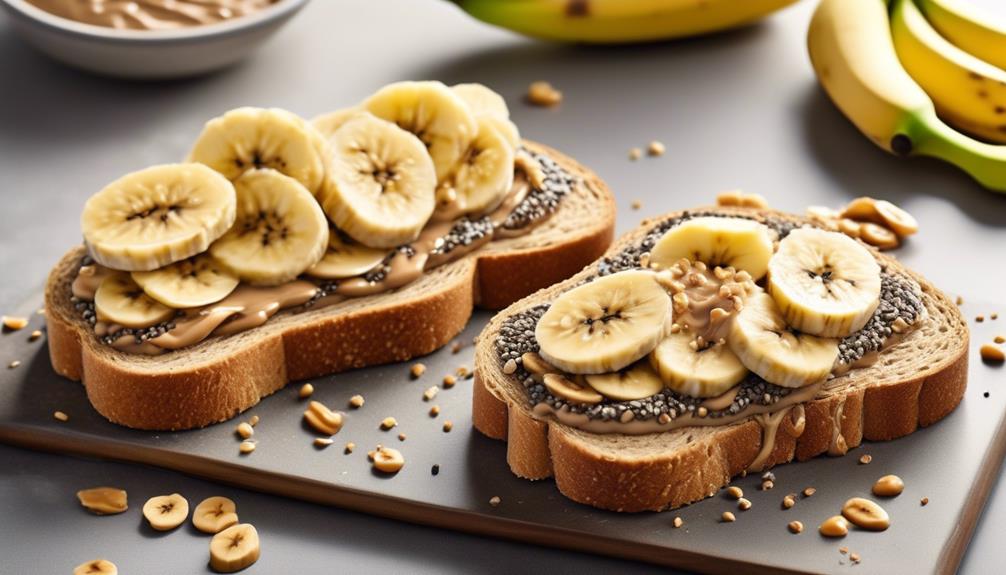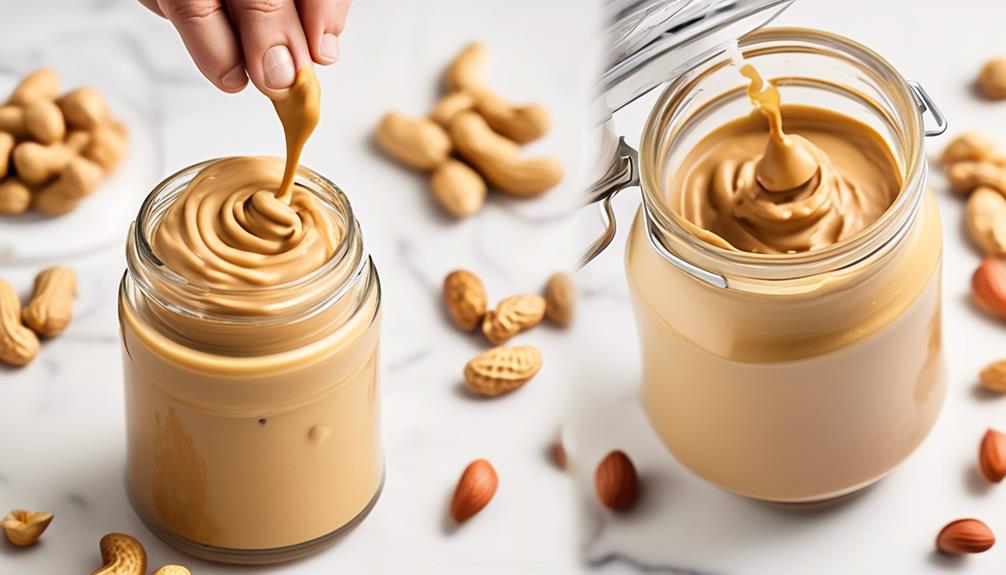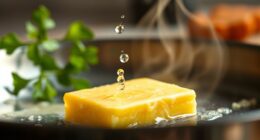Have you ever pondered about what makes peanut butter taste so irresistible?
The rich, creamy texture and slightly sweet flavor make it a staple in many households, but there's more to it than meets the eye.
As we explore the complexities of peanut butter taste, we'll uncover the role of roasting in enhancing its flavor, the science behind its velvety texture, and the latest innovations that have transformed this beloved spread.
Join us as we unravel the delightful mystery of how peanut butter tantalizes our taste buds with every spoonful.
Key Takeaways
- The taste of peanut butter has evolved over time, influenced by factors such as the roasting process and the addition of ingredients like salt or sweeteners.
- Roasting releases natural oils in peanuts, contributing to the rich and nutty flavor of peanut butter.
- Different roasting levels can achieve varying degrees of nuttiness and depth of flavor.
- The texture of peanut butter is significantly influenced by the intensity of roasting, with proper roasting resulting in a smooth and creamy consistency.
The Origin of Peanut Butter
The origin of peanut butter can be traced back to the ancient Incas, who ground roasted peanuts into a paste-like substance. This early form of peanut butter was a simple yet innovative creation, laying the foundation for the beloved spread we know today.
The taste of peanut butter has evolved over time, with variations in flavor influenced by factors such as the roasting process and the addition of ingredients like salt or sweeteners. The rich and satisfying flavor of peanut butter, often described as creamy, nutty, and slightly sweet, has captivated palates for centuries.
The origin of peanut butter provides insight into the deep-rooted history of this popular food. Understanding its beginnings offers a glimpse into the culinary ingenuity of ancient civilizations and their ability to transform humble ingredients into culinary delights.
This historical context adds depth to the appreciation of peanut butter's taste, as it highlights the centuries-long journey of perfecting the flavor and texture that we enjoy today. The origin of peanut butter serves as a testament to the enduring appeal of its taste and the enduring legacy of this beloved food.
The Role of Roasting

When peanuts undergo the roasting process, their natural oils are released, contributing to the rich and nutty flavor of peanut butter.
The roasting process also plays a crucial role in developing the slightly sweet and caramelized taste that enhances the overall flavor profile of peanut butter.
Additionally, different roasting levels can be utilized to achieve varying degrees of nuttiness and depth of flavor in the final product.
Roasting and Flavor
Roasting peanuts is a crucial step in the production of peanut butter, as it intensifies the natural flavors and contributes to the rich and nutty taste characteristic of this popular spread.
When peanuts are roasted, the Maillard reaction occurs, leading to the development of complex flavors and aromas. This reaction involves the interaction between amino acids and reducing sugars, resulting in the characteristic nutty and roasted taste.
Additionally, roasting helps break down the proteins and fats in peanuts, enhancing the overall flavor profile of the peanut butter. The process also plays a significant role in creating the creamy yet slightly grainy texture that's highly desirable in peanut butter.
Different roasting techniques can impart distinct flavor profiles to peanut butter, offering a diverse range of taste experiences for consumers.
Ultimately, the roasting of peanuts is integral to the delightful taste and texture of peanut butter.
Impact on Texture
Transitioning from the discussion of roasting and flavor in peanut butter production, we now turn to the crucial role that roasting plays in determining the texture of this popular spread. The roasting process significantly impacts the texture of peanut butter, influencing whether it will be smooth and creamy or dry and crumbly. The table below illustrates the effects of roasting on the texture of peanut butter.
| Roasting Intensity | Texture |
|---|---|
| Light | Creamy |
| Moderate | Smooth |
| Heavy | Grainy |
| Over-roasted | Dry |
Proper roasting enhances the overall mouthfeel, reducing graininess and creating a velvety consistency in creamy peanut butter. However, over-roasting can lead to a drier and less spreadable texture. Achieving the ideal roasting intensity is crucial in creating a peanut butter with the desired texture and sensory experience.
Understanding Peanut Flavor

Understanding the flavor of peanut butter is essential for appreciating its creamy, nutty, and slightly sweet profile, which varies depending on factors such as brand, type, and roasting techniques. When considering the peanut flavor, it's important to note that:
- Natural Variations:
- The taste of peanut butter can vary significantly between brands and types. Some may have a more intense, roasted flavor, while others offer a milder, sweeter profile. This variety allows for diverse culinary applications and caters to individual preferences.
- Roasting Process:
- The roasting process plays a crucial role in developing the distinct peanut flavor. By roasting the peanuts, their natural oils are released, intensifying the nutty taste and contributing to the overall aromatic profile.
The interplay of these factors leads to the rich and satisfying taste that characterizes peanut butter. The inherent creaminess, combined with a slightly grainy texture, enhances the overall flavor experience.
Through a nuanced understanding of peanut flavor, one can truly appreciate the complexity and versatility of this beloved spread.
The Science of Texture

When it comes to peanut butter, the science of texture is a fascinating subject to explore.
We can analyze how the smoothness, creaminess, and graininess of peanut butter impact our sensory perception and overall eating experience.
Texture and Mouthfeel
The mouthfeel of a food product is determined by its physical properties, including viscosity, elasticity, and cohesiveness, which collectively contribute to the overall sensory experience.
When it comes to peanut butter, the creamy texture plays a vital role in its mouthfeel, impacting the way it coats the tongue and palate. This creamy attribute is a result of the finely ground peanuts and their natural oils, which contribute to the smooth and spreadable consistency.
Furthermore, the balance between firmness and spreadability is crucial in creating the desired mouthfeel, ensuring that the peanut butter is both easy to spread and enjoyable to eat.
The cohesive nature of peanut butter also influences its mouthfeel, providing a satisfying sensation as it sticks to the roof of the mouth, allowing for a prolonged taste experience.
Sensory Perception
Studying sensory perception, specifically the science of texture, involves a detailed examination of how our senses interact with food at a physical level, influencing our overall experience and enjoyment. When it comes to peanut butter, the science of texture plays a crucial role in shaping our sensory perception of this beloved spread. Our perception of peanut butter's texture is influenced by factors such as its smoothness, viscosity, and mouthfeel. Through this intricate interaction, our taste buds and tactile senses work in unison to create a holistic experience of peanut butter consumption. This sensory experience greatly impacts our overall enjoyment and satisfaction with the product. Understanding the science of texture allows us to appreciate the complexities behind our sensory perception of peanut butter, leading to a deeper appreciation of its flavor and quality.
| Texture Attributes | Influence on Sensory Perception | Example |
|---|---|---|
| Smoothness | Enhanced creaminess | Creamy peanut butter |
| Viscosity | Perception of thickness | Thick, rich peanut butter |
| Mouthfeel | Sensation in the mouth | Smooth and velvety texture |
Physical Properties
Exploring peanut butter's physical properties offers valuable insights into its texture and how it influences our sensory perception and enjoyment of the spread.
When we consider the physical properties of peanut butter, we're delving into its tactile experience and mouthfeel, which play a significant role in shaping our overall perception of this beloved food. These properties are influenced by several factors, such as the size and distribution of solid particles and the viscosity of the oil phase.
Understanding these elements can provide a deeper understanding of why peanut butter tastes the way it does and how it behaves when we interact with it. The interplay of these physical properties contributes to the creamy, smooth, or crunchy texture that defines our peanut butter experience.
Nutritional Impact

With its rich content of healthy fats, protein, and essential nutrients, peanut butter presents a compelling nutritional profile for inclusion in a well-rounded diet. It serves as a good source of energy and can aid in muscle growth and repair. However, moderation is crucial due to its high calorie content, as excessive consumption can lead to weight gain. When selecting peanut butter, opt for natural options with minimal added sugars and unhealthy fats for a healthier choice. Below is a breakdown of the nutritional impact of a popular peanut butter brand, Jif Creamy Peanut, per 2 tablespoon serving:
| Nutrient | Amount |
|---|---|
| Calories | 190 |
| Total Fat | 16g |
| Saturated Fat | 3g |
| Protein | 7g |
| Carbohydrates | 8g |
Peanut butter can be a versatile addition to various recipes and snacks, enhancing both flavor and nutritional value. It's important to consider the nutritional impact of peanut butter in the context of an overall balanced diet.
Spreadability Secrets

When considering the spreadability of peanut butter, it's important to understand the factors that contribute to its smoothness and texture.
The consistency of peanut butter, whether smooth or chunky, plays a significant role in its spreadability.
Additionally, the techniques used to alter its texture, such as blending with honey or storing it at room temperature, can greatly impact its spreadability.
Smooth Vs. Chunky
In comparing smooth and chunky peanut butter, one can immediately discern the contrasting textures and flavor profiles that each variety offers.
- Smooth Peanut Butter
- Offers a creamy, velvety texture that glides effortlessly on bread or crackers.
- Easier to spread and ideal for baking and cooking applications.
- Chunky Peanut Butter
- Contains small, crunchy peanut pieces that provide a satisfying texture and nutty flavor.
- Adds a delightful crunch and extra peanut flavor to sandwiches and snacks.
The choice between smooth and chunky peanut butter ultimately comes down to personal preference and desired texture in your dishes. Whether you prefer the creamy spreadability of smooth peanut butter or the satisfying crunch of chunky, both varieties offer unique experiences that cater to individual tastes and preferences.
Consistency and Texture
To achieve the ideal spreadability and texture of peanut butter, manufacturers often carefully balance the oil content and grind size of the peanuts. The consistency and texture of peanut butter play crucial roles in its overall appeal.
Smooth peanut butter, with its creamy and spreadable texture, is achieved through finely grinding the peanuts and carefully controlling the oil content.
On the other hand, chunky peanut butter, with its coarser texture, contains slightly larger peanut pieces, providing a delightful crunch.
The oil content also affects the consistency, with some brands offering a loose and oily texture, while others have a smoother, more cohesive feel.
Paying attention to these factors ensures that peanut butter maintains its desired spreadability and texture, providing a satisfying experience for consumers.
The Creamy Vs. Crunchy Debate

Certainly! Typically, individuals have strong preferences for either the creamy or crunchy variety of peanut butter based on their textural and flavor preferences. When it comes to the creamy vs. crunchy debate, there are several factors to consider:
- Texture Preference
- Some individuals lean towards creamy peanut butter for its smooth, spreadable texture, while others prefer the satisfying crunch offered by crunchy peanut butter with added peanut pieces.
- Spreadability Factor
- Creamy peanut butter is easier to spread on bread, making it a convenient choice for sandwiches and snacks. On the other hand, crunchy peanut butter adds a delightful texture to various foods.
The debate extends to specific peanut butter products like Skippy Creamy and Jif Peanut Butter, each offering a unique take on the creamy or crunchy dilemma. For those who crave an intensified crunch, options like 'Extra Crunchy' peanut butter provide an even more robust nutty experience.
Understanding these distinctions can help individuals make informed choices based on their personal preferences and culinary needs.
Sweet & Salty Combinations

Exploring the intricate interplay of sweet and salty flavors in culinary creations reveals a diverse array of tantalizing taste sensations. When it comes to peanut butter, the combination of sweet and salty is a classic and beloved flavor profile. The table below showcases some popular sweet and salty combinations, demonstrating the versatility and widespread appeal of this flavor pairing.
| Sweet & Salty Combinations | Description | Culinary Examples |
|---|---|---|
| Chocolate-covered Pretzels | The combination of rich chocolate and salty | Chocolate-covered pretzels |
| pretzels creates a satisfying contrast in | ||
| flavors, offering a delightful snacking option. | ||
| Salted Caramel | The sweetness of caramel paired with a hint of | Salted caramel sauce, caramel |
| salt provides a complex and indulgent flavor | candies, ice cream toppings | |
| experience that is both savory and sweet. | ||
| Honey Roasted Nuts | The natural sweetness of honey combined with | Honey roasted peanuts, almonds, |
| the savory crunch of roasted nuts delivers a | cashews | |
| delectable and satisfying snack option. |
Peanut butter, with its rich, creamy texture and natural nuttiness, pairs exceptionally well with both sweet and salty elements. Whether it's the classic combination of peanut butter and jelly, or the more adventurous fusion with soy sauce and honey, the interplay of sweet and salty flavors elevates the taste of peanut butter to new heights.
Peanut Butter Pairings

The intricate interplay of sweet and salty flavors in culinary creations transitions seamlessly into the realm of peanut butter pairings, where its rich, creamy texture and natural nuttiness elevate a diverse array of flavor combinations.
When considering peanut butter pairings, several options stand out:
- Fruit Combinations
- *Bananas*: Pairing peanut butter with bananas creates a delightful contrast of creamy and sweet, with the banana's natural sugars enhancing the nutty flavor of the peanut butter.
- *Apples*: Combining peanut butter with apples offers a satisfying crunch and a perfect balance of sweetness and nuttiness, creating a refreshing and nutritious snack.
- Indulgent Treats
- *Chocolate*: Incorporating peanut butter into chocolate-based treats creates a classic and indulgent flavor pairing, perfect for desserts or snacks, where the creamy, nutty peanut butter complements the rich sweetness of chocolate.
Peanut butter's versatility makes it an ideal companion for various foods, offering a harmonious blend of flavors and textures. Whether it's a healthy snack or a decadent treat, the potential for delightful pairings with peanut butter is endless.
Global Peanut Butter Preferences

When it comes to global peanut butter preferences, there's a wide range of flavors and textures that influence consumer choices.
Some regions prefer sweeter and smoother peanut butter, while others lean towards a more natural, nutty flavor with a slightly gritty texture.
Additionally, cultural and regional influences play a significant role in shaping these preferences, with some areas favoring more savory or sweet profiles.
Popular Peanut Butter Flavors
With a myriad of options available worldwide, peanut butter flavors span the spectrum from classic creamy to innovative blends, reflecting diverse global preferences. When it comes to popular peanut butter flavors, several trends stand out:
- Classic Varieties:
Leading brands like Jif and Skippy offer traditional creamy and crunchy options that remain popular, providing a familiar taste for consumers.
These classic varieties are often preferred for their versatility, suitable for anything from sandwiches to baking.
- Innovative Blends:
Brands such as Justin's and Peanut Butter & Co. have introduced innovative flavors like honey, cinnamon, and chocolate, catering to the evolving taste preferences of consumers seeking unique and indulgent experiences.
These popular brands continue to drive the evolution of peanut butter flavors, offering a wide range of options to suit various taste preferences and culinary applications.
Regional Peanut Butter Textures
Exploring regional peanut butter preferences provides valuable insights into the diverse textures and tastes influenced by unique culinary practices and preferences around the world.
In some regions, the best peanut butter tends to have a creamy and smooth texture, often preferred in North America, while other areas, such as parts of Asia and Africa, lean towards a chunky and gritty texture. These differences can be attributed to the type of peanuts used, the roasting process, and the presence of additives and preservatives.
Almond butter, a popular alternative, varies in texture as well, often being smoother and creamier than traditional peanut butter. Understanding these regional peanut butter textures can lead to a greater appreciation for the diversity and nuances in taste and texture across different cultures and regions.
It's fascinating to observe how these preferences influence the products found in local health food shops globally.
Sweet Vs. Savory Preferences
How do global peanut butter preferences vary between sweet and savory options?
When it comes to peanut butter, global preferences are divided between sweet and savory options, influenced by cultural and regional factors.
- Cultural Influences
- Some cultures prefer sweetened peanut butter with added sugar, honey, or chocolate, reflecting a taste for indulgent flavors.
- Other regions lean towards savory, natural peanut butter without added sweeteners, reflecting a preference for more earthy and nutty flavors.
These preferences are heavily influenced by regional cuisines and traditional dishes, shaping the way people enjoy their peanut butter.
Ultimately, the choice between sweet and savory peanut butter reflects personal taste, influenced by individual flavor preferences and culinary traditions.
Production Process Insights

The production process of peanut butter involves carefully selecting and roasting high-quality peanuts to enhance their natural flavors before being processed into the rich, creamy, and delectable spread enjoyed by consumers worldwide. The roasting process is crucial, as it brings out the nutty and slightly sweet flavors of the peanuts, contributing to the overall taste of peanut butter. Additionally, improvements in natural peanut butter taste have been driven by consumer demand for more flavorful and healthier options. As a result, the simplicity of natural peanut butter, made with just peanuts, allows the natural flavors to shine, contributing to its deliciousness.
| Ingredients | Function | Source |
|---|---|---|
| Palm Oil | Prevents oil separation | Palm fruit |
| Mono and Diglycerides | Emulsifiers | Rapeseed and Soybean |
The production process often includes the addition of palm oil to prevent oil separation and maintain a creamy texture. Emulsifiers like mono and diglycerides, sourced from rapeseed and soybean, are also used to enhance the spreadability and texture of peanut butter. These insights into the production process shed light on the meticulous steps taken to create the perfect blend of flavors and textures in peanut butter.
Peanut Butter's Shelf Life

Insights gleaned from the production process of peanut butter play a crucial role in understanding the factors influencing its shelf life. The shelf life of peanut butter, such as Jif, is influenced by various factors:
- Storage Conditions:
- Peanut butter usually has a shelf life of about 6-9 months after opening, if stored in a cool, dry place.
- Refrigerating peanut butter can extend its shelf life, especially for natural varieties, by preventing the oils from going rancid.
- Type of Peanut Butter:
- Natural peanut butter, without added preservatives, may have a shorter shelf life, typically around 3-6 months after opening.
- Properly sealed and stored unopened jars of peanut butter can last for up to 2 years, but it's essential to check the expiration date.
Understanding these factors is essential to maintaining the quality of peanut butter and ensuring its safety for consumption. As the oils in peanut butter can turn rancid over time, proper storage and monitoring for signs of spoilage, such as a rancid smell, off taste, or oil separation, are vital for enjoying peanut butter at its best.
Allergies and Sensitivities

Allergies and sensitivities to peanut butter can elicit a wide range of symptoms, varying from mild reactions to severe anaphylaxis, making it crucial for individuals to be vigilant about potential allergens.
For some, the creamy richness of Peter Pan Creamy peanut butter may trigger hives, stomach pain, or even difficulty breathing. It's a stark reminder that even a small taste of peanuts can have life-threatening consequences for those with severe allergies.
Tasting like peanuts isn't always a welcome sensation for those with sensitivities. Whether it's a childhood allergy that persists into adulthood or a newly developed sensitivity, the impact can be significant.
Cross-contamination is a constant concern, and even the slightest exposure to peanut butter can lead to distressing reactions. It's not just the pure peanut taste that's the issue; additives like sugar and palm oil can also trigger digestive discomfort for some individuals.
Navigating social situations and dining out is a delicate balance for those with peanut butter allergies and sensitivities, requiring clear communication and careful scrutiny of ingredients.
Innovations in Peanut Butter

Navigating the world of peanut butter, particularly for those with allergies and sensitivities, has prompted ongoing innovations in the industry to cater to diverse dietary needs and preferences. The market now offers a variety of innovative peanut butter options to meet consumer demands, including:
- No Sugar Added Options:
- Brands like Justin's Classic Peanut Butter provide a homemade taste with a loose and grainy consistency, appealing to those seeking natural peanut butter without added sugars.
- Alternative Flavor Profiles:
- Target's Good & Gather Creamy Peanut Butter, with its inclusion of dry roasted peanuts, sugar, hydrogenated oils, molasses, and mono and diglycerides, offers a unique flavor profile and powdery texture, catering to individuals with different taste preferences.
These innovations in peanut butter not only address dietary concerns but also offer diverse sensory experiences. As consumers continue to seek natural peanut butter options and unconventional flavor combinations, the industry is likely to witness further advancements and creative iterations to meet evolving preferences.
Frequently Asked Questions
Does Peanut Butter Taste Good?
Oh, absolutely! Peanut butter tastes delicious to many of us. Its rich, creamy, nutty flavor with a hint of sweetness is quite appealing. The roasting process enhances its taste, and natural peanut butter, made solely from peanuts, offers a simple and natural flavor.
The creamy yet slightly grainy texture adds to the overall taste experience. Different brands and varieties cater to diverse preferences, making it a versatile and enjoyable food.
How Do You Describe Peanut Butter Taste?
We've explored the multifaceted aspects of peanut butter taste. It embodies a rich, creamy, nutty flavor with a hint of sweetness.
Variations in taste arise from processing methods and the type of peanuts used. Roasting the peanuts intensifies the flavor profile. The natural oils in peanuts contribute to its texture and taste.
This culminates in a creamy, slightly grainy consistency that enhances the overall taste experience.
What Is the Flavor of Peanut Butter?
The flavor of peanut butter is rich, creamy, and slightly sweet. It varies depending on the brand and type, with some being more robust and others more mild.
Roasting the peanuts before processing enhances the nuttiness. The natural oils in peanuts contribute to its satisfying richness. The absence of additives and the roasting process influence its delicious and versatile flavor.
Is Peanut Butter Sweet or Sour?
Peanut butter has a naturally sweet taste due to the presence of sugar in peanuts. The sweetness is balanced with a subtle nuttiness, and there's no sourness in the flavor profile.
This unique combination of flavors makes peanut butter a popular choice for many. The sweetness of peanut butter is a key factor in its widespread appeal and versatility in both savory and sweet dishes.
Conclusion
In conclusion, peanut butter has come a long way in terms of taste and texture, thanks to advancements in roasting techniques and production processes.
The creamy, nutty flavor coupled with its smooth and silky texture makes it a timeless favorite.
With innovative companies like Smuckers leading the way, peanut butter continues to evolve, offering a delicious and nutritious spread that stands the test of time.
It's truly a classic that never goes out of style.
